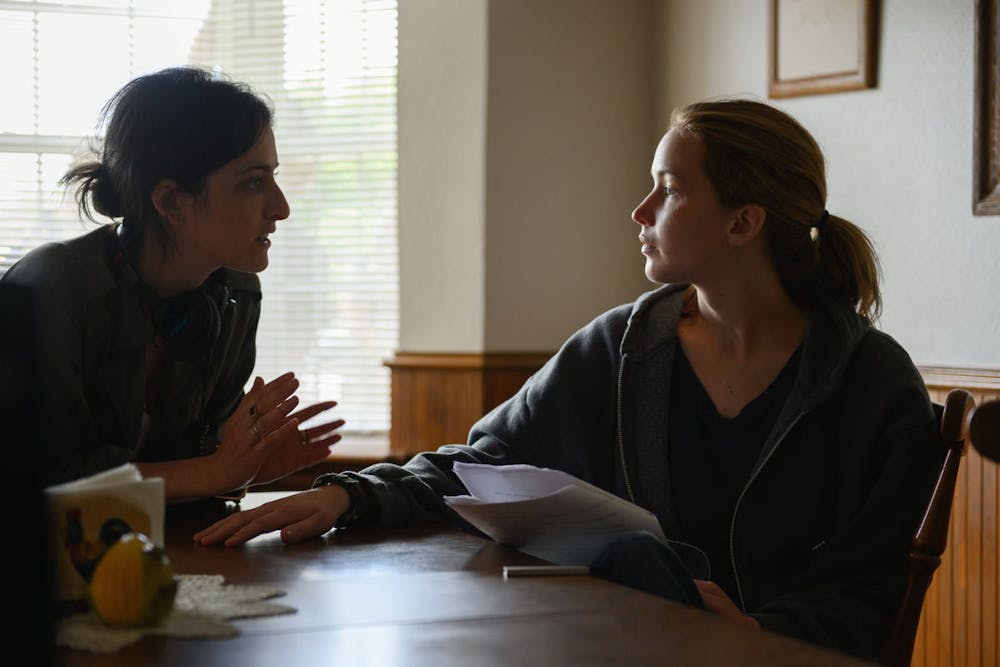In a cinematic landscape increasingly focused on aesthetics, a film that opts for minimalism stands out. A disregard for flashy sets, fast action and shock value may seem counterproductive when seeking to capture an audience’s immediate attention. But if done well, simplicity can be extremely effective. Lila Neugebauer’s “Causeway” deftly demonstrates the power of simplicity, proving that a film does not need to excessively pack in action in order to move its audience.
“Causeway” stars Jennifer Lawrence as Lynsey, an American soldier suffering from post-traumatic stress disorder and depression. After a traumatic brain injury in Afghanistan, Lynsey is discharged to recover. Shortly after the film begins, viewers watch her leave rehab, but it soon becomes apparent that her mind is not yet settled. Lynsey seems removed and somber — present physically but not yet mentally. She has nightmares and struggles to maintain complete control over her body. What’s more, she feels confined living with her mother (Linda Emond) in her childhood home. After Lynsey’s car breaks down, it is only a matter of time before she does as well.
Still, Lynsey is unwaveringly insistent that she is “fine.” She takes a job maintaining pools but views the position as only temporary. Her plan, against the advice of both her mother and doctor (Stephen McKinley Henderson), is to apply for redeployment once her health permits it.
Early in the film, Lynsey meets and immediately connects with James Aucoin (Brian Tyree Henry). Although he is the mechanic fixing her car, their relationship moves well beyond strictly professional. Before long, James is driving Lynsey to her doctor’s appointments and buying her snow cones, eventually asking her to move in with him. But as their relationship develops, Lynsey retreats from him, as she does with all of the people in her life. She empathizes with his own trauma, a car accident which resulted in the loss of one of his legs, but simultaneously pities him.
Keeping with the pacing of the rest of the film, there is no singular impetus for Lynsey and James to reconcile. Instead, it is time and reflection that change both of their minds, just as it is time and reflection that direct the entire thematic course of the movie. The film’s climactic moments consist of long-overdue expressions of vulnerability between characters, but even in these scenes, dialogue and background music remain sparse. The focus instead is on the characters’ connection — how they inhale, look at each other and finally share what they know should have been said earlier.
Fittingly, one of the most emotional scenes of the entire film has almost no dialogue in it whatsoever. Only Lynsey and her brother (Russell Harvard) appear on screen, and she looks at him from the other side of a glass divider as she visits him in prison. Their entire conversation is in sign language, and so the scene instead relies on sighs, soft chuckles and suppressed tears, rather than spoken words. It is a testament to the modesty of the film, in which even the sounds of language are deemed unnecessary to elicit strong emotion.
Lawrence’s casting for this role makes perfect sense given her often subtle acting style. As a result, she embodies the role of Lynsey seamlessly. There are several shots of her simply standing at the edge of a calm pool, moments that capture her character’s all-encompassing stillness. It is perhaps during these moments that Lawrence is at her best in the film, communicating everything while saying absolutely nothing at all.
Henry is similarly impressive. He is more talkative than Lawrence, but such is his role in the film: Though he struggles with his own trauma, he is more forthcoming. The two balance each other beautifully.
Although “Causeway” does not necessarily fit into the current stream of popular cinematic culture, it is still valuable as a work of art. Neugebauer has made both a bold and admirable decision in directing with such minimalism. The film will likely not be up for an Oscar, nor is it going to make considerable waves on social media. But such standards do not detract from its ability to leave audiences emotionally satisfied. “Causeway” lets viewers walk away content, needing nothing more.

Rya is an Arts & Culture editor from Albany, NY. She is a senior studying English and Literary Arts, and her favorite TV show is Breaking Bad.





